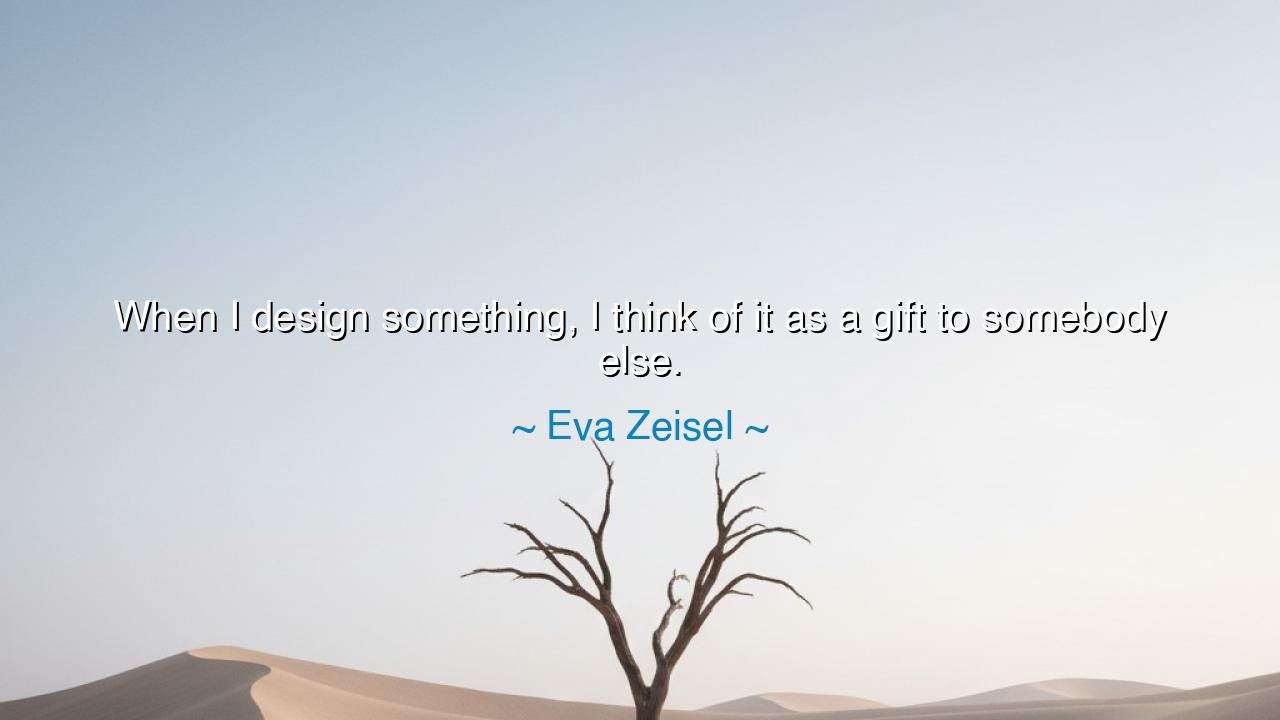
When I design something, I think of it as a gift to somebody






“When I design something, I think of it as a gift to somebody else.” Thus spoke Eva Zeisel, the master of form and grace, a woman who shaped clay as though she were shaping the spirit of generosity itself. In this simple yet profound statement lies a philosophy that transcends design—it is a creed of creation with love, a reminder that all true art, all true craft, must be born not from ego, but from service and compassion. To design, in Zeisel’s mind, was not an act of self-expression alone, but of giving, of making something beautiful so that others might live more beautifully.
Zeisel’s words carry the quiet power of a life shaped by both suffering and wonder. Born in Hungary in 1906, she lived through revolution, imprisonment, exile, and rebirth. She knew the fragility of life, and thus she treated every act of creation as sacred. When she says that design is a gift, it is not metaphor—it is revelation. She understood that to craft an object—a teacup, a vase, a table—is to enter into relationship with another soul, to create something that will dwell in their hands, their homes, their memories. Each curve of porcelain, each gentle line of design, was her way of whispering kindness into the world.
To create as a gift is to invert the natural order of pride. The designer who creates for fame, for applause, or for profit makes an object that flatters the moment but dies with it. But the designer who creates for another human being—for comfort, for joy, for beauty—builds something that endures beyond their own lifetime. In this sense, Zeisel’s philosophy mirrors that of the ancient artisans who built cathedrals, not for their own names to be remembered, but for the glory of something higher. The mason who carved a rose into a stone arch that no eye would ever see did so because love itself was reason enough. So too did Zeisel shape her work with the devotion of one who gives without demand, finding fulfillment in the act itself.
History tells us that this selfless artistry has long been the soul of civilization. Think of Bernini, who designed the grand colonnade that embraces the faithful before St. Peter’s Basilica. Its sweeping arms of marble were not meant merely to impress the eye, but to welcome humanity, to enfold the pilgrim in grace. Bernini, like Zeisel, understood that design could be an act of love translated into structure, a form of wordless generosity that speaks across centuries. The greatest designs—whether in architecture, pottery, or music—carry within them the spirit of giving, the artist’s invisible hand extended to the world.
To think of design as a gift is also to recognize the moral dimension of beauty. Every creator holds the power to shape not only form, but feeling. A chair can teach rest; a lamp can teach warmth; a cup can teach gentleness. Zeisel believed that even the simplest household object could elevate life, if it was made with thought, care, and tenderness. “Design,” in her world, was not about invention for its own sake, but about harmony—between maker and user, between human and object, between art and life. The true designer, like the true friend, gives with intention, seeking not to impress, but to serve.
And yet, her wisdom extends beyond design into the very art of living. For what is life itself, if not a continuous act of creation—and what is creation, if not the offering of ourselves to others? To live as Zeisel designed is to make of one’s words, one’s deeds, and one’s days a series of gifts—each small, but sincere. A smile, a kindness, a task done with care—these too are designs, shaping the invisible architecture of human connection. When we begin to see our work, our art, and our actions as offerings, the world becomes softer, more meaningful, more whole.
Thus, let this be the lesson passed down from Eva Zeisel, the sculptor of beauty and giver of grace: create as a gift. Whether your tools are clay, words, ideas, or hands—let your craft arise not from vanity, but from love. Think, as you work, of the unseen person who will one day hold what you have made. Let your labor become a conversation with their future joy. For in this, you will discover the truest form of immortality—not the preservation of your name, but the continuation of your kindness.
And so I say: work not to conquer, but to contribute. Shape your creations with the heart of a giver, not the pride of a maker. For in the end, the world will forget the names of its designers—but it will never forget the warmth of their gifts. To design something as a gift is to leave behind more than an object—it is to leave behind love made visible, a quiet legacy that outlives the hands that formed it.






AAdministratorAdministrator
Welcome, honored guests. Please leave a comment, we will respond soon